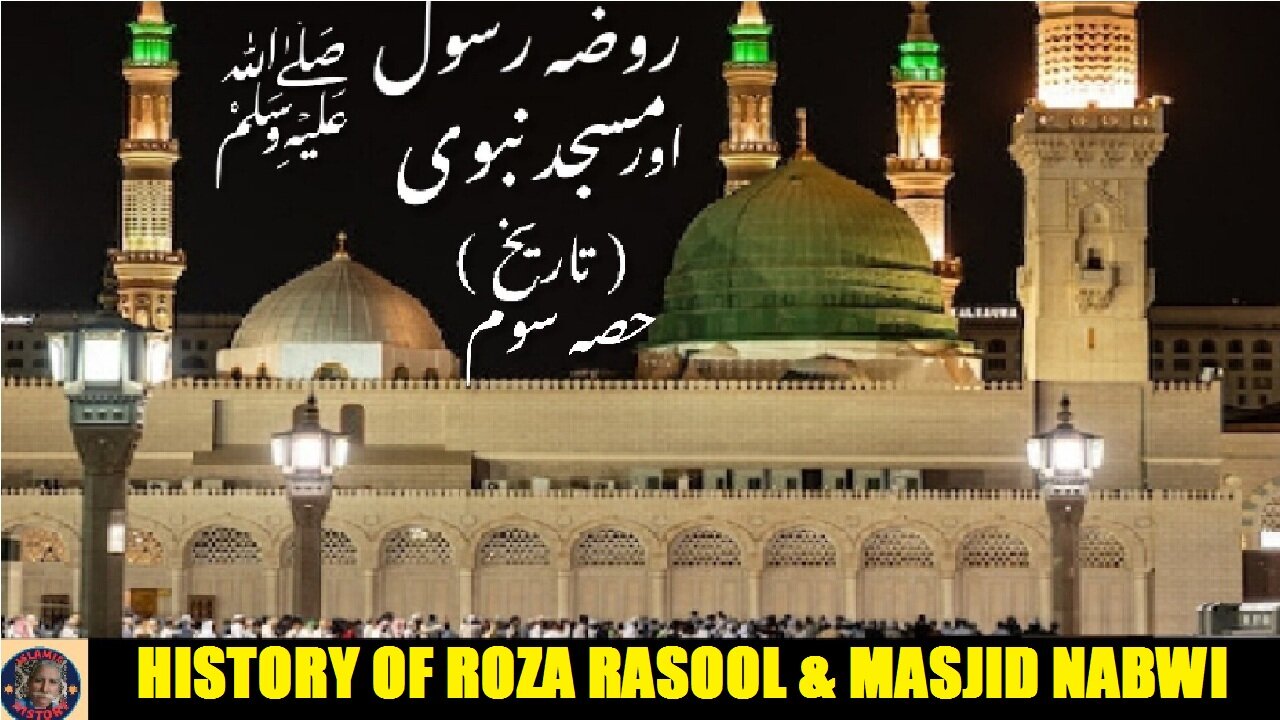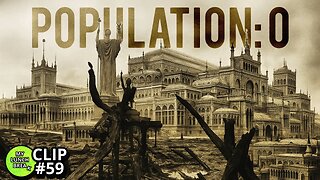Premium Only Content

Part-3 History of Roza Rasool and Masjid Nabwi روضہ رسول اور مسجد نبوی صلی اللہ علیہ وسلم کی تاریخ
@islamichistory813 #TombOfTheProphetMuhammad #SacredChamber #IslamicHistory
Part-3
History of Roza Rasool and Masjid Nabwi (Peace be upon Him)
Asslamoalaikum sisters brothers friends and elders, We are contineu going to start describing from where yesterday we was stop describing the Tomb (Roza Rasool) of the Prophet Muhammad SAW (The Sacred Chamber, its is third part of topic.
History of the Sacred Chamber
The Hujarat
The house of Aisha bin Abu Bakr J and the other wives of the Prophet ? were known as the hujurat (the Chambers) after which a whole chapter of the Quran (chapter 49) is named. These hujurat were made of the same material with which Masjid Nabawi was built – clay bricks with fibres from date trees and were located adjacent to the mosque itself. Below is a model of what the Masjid and the hujarat may have looked like:
Each house consisted of one room, approximately 5m x 4m in size and a small backyard. The ceiling of each house could be touched with an upraised hand.
When the Prophet ? migrated to Madinah, he had two wives – Aisha J and Sawda bint Zam’a J, who was his second wife. Houses for both of them were built next to each other adjacent to the rear of Masjid Nabawi (which became the front of the mosque when the Qibla changed direction, from north to south).
The house of Hafsa bint Umar J, the fourth wife of the Prophet ? and the daughter of Umar ibn al-Khattab I was built south of the house of Aisha J soon after. A narrow street separated the houses, which was just wide enough for one person to walk through. The two homes were so close to each other that Aisha and Hafsa K would often converse with each other whilst sitting in their own rooms. A portion of the house belonging to Hafsa J is today located inside the Sacred Chamber, and the remaining portion is where visitors stand when greeting the Prophet ?.
The Prophet ? also had a house built for his daughter Fatima J and his son-in-law, Ali ibn Ali Talib I. This house was situated south of Aisha’s chambers and was the location in which the couple got married. The Prophet ? would sometimes look through an opening of this house to enquire about Fatima J.
The house belonging to Aisha J had two doors, one leading to Masjid Nabawi and the other opening towards the north. It was special in many ways. The blessed Prophet ? received countless revelations in these chambers, as he himself said:
O Umm Salama, do not hurt me in regards to Aisha for I have not received revelations while I was lying under the cover of any woman among you except Aisha.9
The blessed Prophet ?, after seeking permission from his other wives, stayed here for the last few days of his life.
After the Demise of the Prophet – 11 AH (632 CE) ?
When the Prophet ? passed away in 11 AH (632 CE), a grave was dug for him in the house of Aisha J and he was buried directly beneath his bed. Two years later, his companion Abu Bakr al-Siddiq I was buried next to him. Ten years after that, Umar ibn al-Khattab I was buried in the same room.
Aisha I continued to live in the same house which contained the graves of her husband and father and later Umar I. After Umar I was buried, out of respect for him, she put up a partition in the house since he was not a Mahram. She lived in a small space that wasn’t occupied by the graves until she passed away in 58 AH (678 CE), 47 years after the demise of the Prophet ?.
In the Ummayad Era – 91 AH (711 CE)
In 91 AH (711 CE), the houses of the blessed wives of the Prophet ?, which had been inherited by the family of the Prophet ?, were purchased and controversially razed by the Umayyad caliph al-Walid ibn Abd al-Malik I in order to expand Masjid Nabawi. By this point in time, there were no living Sahaba in Madinah, and these houses were unoccupied. However, the great-grandson of the Prophet ?, Ali ibn Husayn Zayn al-Abidin I, would regularly sit in the house and sometimes talk to congregations in Masjid Nabawi from the house.
When news of this spread through Madinah, the people of Madinah were dejected, and sadness filled the air of the blessed City.
Umar ibn Abi Anas I narrates that he was in Masjid Nabawi, while some of the sons of the Sahaba like Abu Salama bin Abd al-Rahman and Abu Umamah ibn Sahl ibn Kharijah bin Zaid sat together L. They were crying, and tears soaked their beards. Abu Umamah I said, “I wish they abandoned this idea so that people would be discouraged from erecting buildings and see what Allah was pleased with for His Prophet, despite the treasures of the earth being placed in his hands”.10
The renowned tabi‘ Sa‘eed ibn al-Musayyab I said, “I swear by Allah, I would have loved it if they had left them untouched. A new generation from Madinah and believers from around the world would gather; they would witness the austerity of the blessed Prophet and would be discouraged from coveting and competing with each other over materialistic pleasures.”11
Umar ibn Abdul Aziz I, the governor of Madinah at the time who went on to become Caliph, took part in the demolition of the hujarat himself. When the house of Aisha J was dismantled, three graves appeared. Rija bin Haiwah I narrates in Fath al-Bari:
Al-Waleed ibn Abdul Malik wrote to Umar ibn Abdul Aziz to purchase the rooms of the wives of Prophet in order to include this space within the confines of the mosque. When the walls of the chambers were removed, these graves became visible. The sandy soil on the graves had somewhat levelled off. Umar ibn Abdul Aziz rebuilt the walls of Aisha’s chamber during the expansion of Masjid Nabawi.
So dear friends, remaining history will be described from here in next video part-4. Allah Hafiz
============================================
-
 10:25
10:25
ISLAMIC HISTORY
1 day agoIslamic History Episode 207 Review of Caliphate of Aminअमीन की खिलाफत की समीक्षा خلافت امین کا جائزہ
1 -
 LIVE
LIVE
Caleb Hammer
18 hours agoHe Just Sucks… | Financial Audit
57 watching -
 LIVE
LIVE
MYLUNCHBREAK CHANNEL PAGE
1 hour agoThe Population Was ZERO
364 watching -
 LIVE
LIVE
Wendy Bell Radio
6 hours agoTrump Cracks The Barrel
7,559 watching -
 LIVE
LIVE
The Big Mig™
2 hours ago2020 Election Fraud Burn Bags Discovered
5,197 watching -
 LIVE
LIVE
Law&Crime
2 hours agoLIVE: Adelson Matriarch Murder Trial — FL v. Donna Adelson — Day 4
129 watching -
 LIVE
LIVE
Badlands Media
10 hours agoBadlands Daily: August 27, 2025
3,613 watching -
 LIVE
LIVE
The State of Freedom
5 hours agoFLF: #15 Obedience to God Unlocks Mysteries & Brings Adventure w/ Dave Hayes
82 watching -
 1:03:42
1:03:42
Crypto Power Hour
3 hours agoWhat Coins Are The Backbone of The New Digital Revolution?
6.36K6 -
 1:22:55
1:22:55
Game On!
19 hours ago $2.62 earnedBREAKING NFL NEWS: Taylor Swift and Travis Kelce Are Engaged!
39.3K13